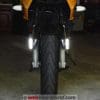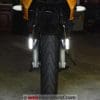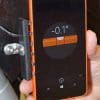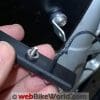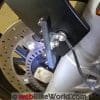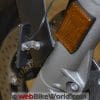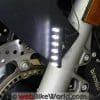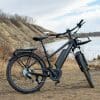The Skene Design Photon Blaster LED lights are sort of like a pumped-up version of the BikeVis Bullets (review).
Their white or amber light can make any motorcycle more visible to oncoming traffic.
They’re fairly easy to install — especially if you can use one of the Skene Design brackets or mounts.
The lights include a patented “Conspicuity Flicker” controller, which modulates the lights in a particular way, adding to the visibility factor.
In addition to the conspicuity factor, the Photon Blasters can also be wired to work as auxiliary turn signals.
Or, for max power, connect up to 8 Photon Blasters each side of the bike! Overkill anyone?
The made-in-the-USA Skene Design motorcycle LED visibility lights are also available as the P3 rear-mounted LED accessory brake lights; the Photon Boosters, which are the Blaster modules only and also available in yellow; and the new ST Lights auxiliary turn signals.
Controller options are also available that allow different light configurations and to convert existing turn signals into running lights.
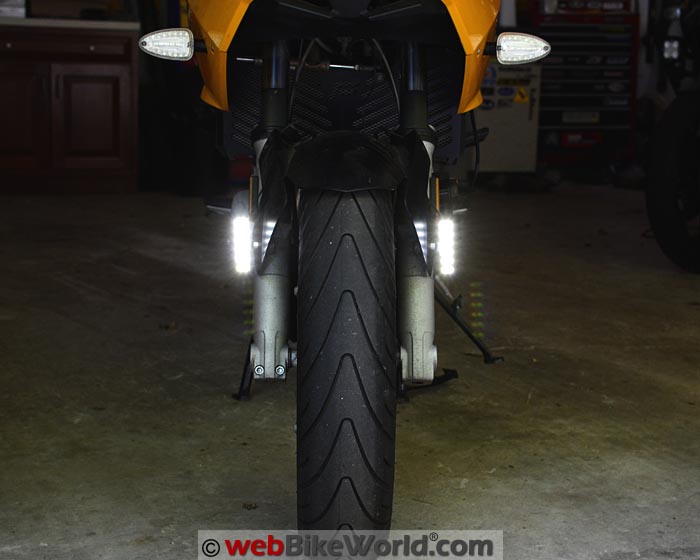
Photon Blaster Background
The Skene Photon Blaster lights are very powerful LEDs that add visibility to the motorcycle to oncoming traffic.
Each light module has 12 bright LEDs in two rows of six. An attached threaded rod on the back is used for mounting and Skene offers a bunch of different mounting brackets and options.
I don’t know what brand of LED that Skene used in the modules, but they claim that each 12-LED Photon Blaster puts out 252,000 millicandela (252 candela) and 504,000 mcd for the pair.
That’s a lot of light, because it’s focused in a 7.5° (15° included) beam, not 360° like a candela measurement (1 candela is supposed to equal the light output of 1 candle).
The Photon Blasters draw 0.35A each and they have a built-in 9 to 16 Volt regulator to account for the sometimes varying voltage on a motorcycle.
The kit (pair) comes with a controller “box” that must be mounted somewhere on the motorcycle. It measures about 76 mm long by 35 mm wide by 15 mm tall. You only need one controller for up to 8 Photon Blaster light modules.
But the lights are very bright, so you probably won’t need more than one pair on the front of the bike for visibility.
Skene Design states that the controller makes the Photon Blasters compatible with the BMW CAN-bus and that is correct, at least on the BMW F 800 S, which accepted the lights no problem and with no electrical error signal.
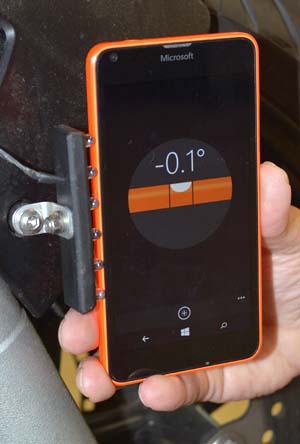
Connecting the Wires
First thing we did before mounting the lights was to temporarily connect all the wiring to make sure everything worked as expected and that there wasn’t a CAN-bus fault.
The most basic wiring is for using the Photon Blasters as conspicuity lights only (wiring diagrams here) but they can also be wired as auxiliary turn signals.
Each light module has a paired wire and the controller module has 4 wires, only 3 of which you need unless you’re using the “Alert” option that flashes the lights when the brakes are applied.
We don’t recommend that option because flashing lights can be interpreted as “It’s ok, go ahead and cut me off” rather than “Stop what you’re doing!”.
Basically, the wiring goes like this: from the light modules and the controller, connect the grounds and the power wires with Posi-Twists (provided in the kit).
Connect the red wire from the controller to a switched power source and connect the black wire to a ground, using a Posi-Tap (provided).
Again, the best way to visualize this is to study the Skene Design wiring diagrams here.
Everything worked as planned on the BMW, so next we mounted the controller with some double-sided sticky tape to the underside of the BMW’s fairing.
Then we routed the wiring down to the lights, mounted the lights, then after leaving enough slack so the forks didn’t bind, we cut the leftover wire and connected everything using the Posi-Twists again.
Mounting the Photon Blasters
When adding accessory lights to a motorcycle, the most difficult part — if you want to call it that — is the mounting and wiring.
Skene Design makes this pretty easy compared to some of the other visibility lights we’ve mounted on the webBikeWorld project bikes over the years, because they have a bunch of brackets and mounts for different motorcycles.
Bike-specific mounts are available for various models by Aprilia, BMW, Ducati, Harley-Davidson, Honda, Kawasaki, Suzuki, Victory and Yamaha.
When you buy a set of Photon Blasters, you get one pair of brackets of your choice. Skene also sells a bunch of brackets and adapters, the combination of which should fit just about any motorcycle.
But even if your bike isn’t listed, the most common mounting option is on the front fender. Replace the bolts that hold the fender to the forks with a longer bolt and offset boss from Skene, add an “L” shaped bracket for aiming and you’re done.
This was easy to do on the BMW F 800 S (Blog), which has a fairly typical fender mounting system.
There are two tricks to a successful installation: first is routing the wiring up around the forks and finding a suitable connection point for splicing. Be sure to leave enough slack in the wires for the vertical and lateral fork movement, but not too much that the wiring gets caught in the wheel.
The second is getting the lights oriented correctly as you tighten the bolts. Skene Design recommends setting the lights as close to vertical as possible.
The problem is that the bracket turns slightly as you tighten the bolts, so it may take some back-and-forth to get this correct.
I used some Loctite also on all the threads to make sure everything stays tight. Don’t over-torque those small-diameter bolts!
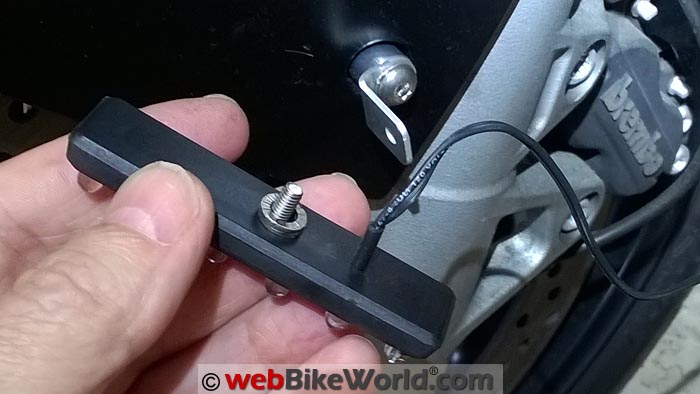
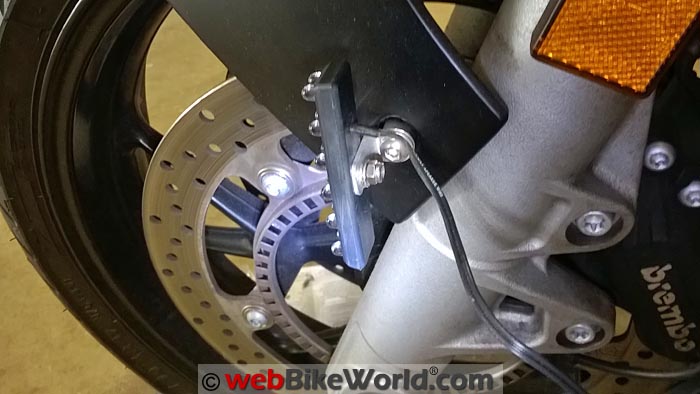
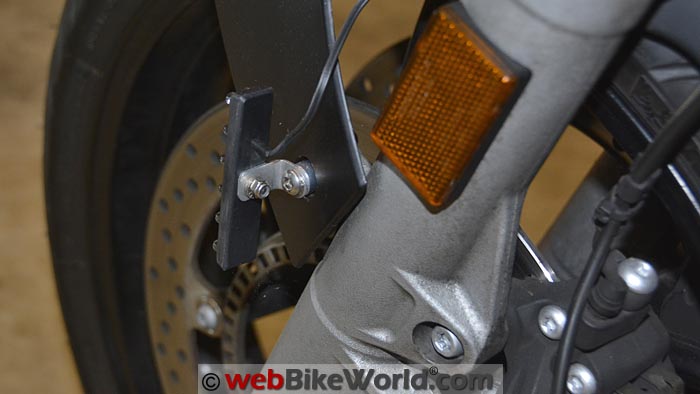
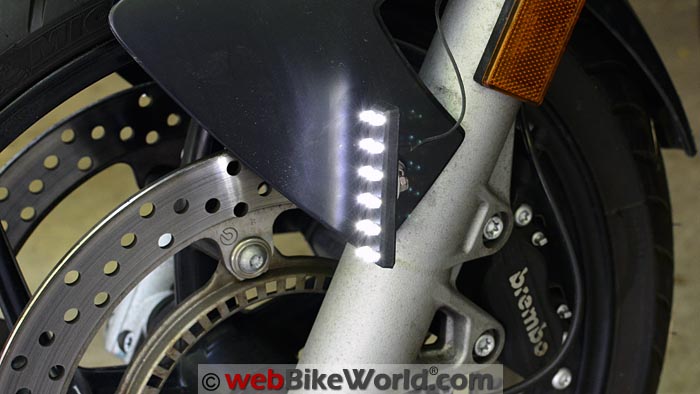
Conclusion
The Skene Design Photon Blasters are very bright. In fact, we were all surprised at first, thinking maybe they were too bright! Is that possible when it comes to conspicuity?
Mounting and wiring the lights isn’t quite as simple as the BikeVis Bullets, but it’s fairly easy, especially if your motorcycle has one of the Skene Design mounts available.
Finding a powered switched wire should be relatively easy also; you can use one of the wires powering a dashboard light.
The patented Skene Design modulator is pretty interesting also; it’s designed so that the lights seem to flicker when seen in peripheral vision. This isn’t enough to distract oncoming traffic but it is enough to bring attention to the bike, which is the primary goal of this type of lighting.
The Photon Blaster kit is rather expensive, but the build quality is good and they work as planned. The lights are also much brighter than most or all of the junk you might find on eBay or elsewhere.
Plus, Jerry Skene is there to answer any questions and there’s a lot of good info on their website.
Owner Comments and Feedback
See details on submitting comments.
From “R.A.” (February 2016): “As others have said, I would not dream of riding without these. I have had the Skene Photon Blasters (front) and P3s (rear) on all my bikes.
As others have said, I see a world of difference in cager behavior with them on. Drivers who are about to mindlessly pull out in front of you from a side road will often jam on their brakes when they take a look. Yes, they’re expensive, but it’s your life, right?”
From “H.S.” (August 2015): “Here’s my $0.02 on the Photon Blasters. My experience is not as sanitary as I’d wish.
In June 2013 I was riding my 2001 BMW 1150GS when an inattentive driver made an illegal U-turn and I whacked him dead center in the passenger side.
Shattered pelvis took 10 weeks to knit, leaving three long screws in place to hold it together. Learning to walk more than a few hundred yards without debilitating pain was… an adventure to say the least.
But now, 26 months after the crash, I am riding again on a 2003 1150 GS that I purchased from a fella near Albuquerque.
I installed the Photon Blasters in the sellers garage and rode the bike back to Sacramento.
On at least three occasions during the ride portion of the Fly-n-Ride adventure, cars were stopped cold when I gave the brakes a double tap and the LED’s did their flashing thing, getting the attention of the drivers before they could pull out and cause another nasty crash.
Bottom line? Despite any reservations that the reviewers might have, the lights work to help make inattentive drivers aware that there is a motorcycle approaching.
Will they stop all idiots from pulling out in front of the MC? No, obviously not.
But what they do do is give peace of mind that you, the MC rider, have done all in your power to ensure that you are as visible as possible. I would not ride my GS in traffic without these lights installed.”
Editor’s Reply: While it is possible that lights may help, the best way to avoid a potential accident is to ride like you’re invisible and assume that other vehicles will do the most ridiculous things.
And always have a Plan A and B escape route in mind.
Riding along while fumbling for the light switch and hoping that the flashing of a very small LED light so that other vehicles won’t do something dumb, is not really a good strategy for survival.
Because flashing of lights is generally accepted as a signal for “go ahead and do it”, I/we recommend not using that method especially for vehicles turning left or ready to pull out in front of you.
Plan on the fact that they will do it and then act defensively.
From “A.J.” (August 2015): “Thanks for a fantastic review site! I need to say up front I have had Jerry’s lights on the last four bikes and will not own a bike without them.
Rather then talk about mounting them or how bright they are, I want to describe my experience using them.
I ride daily in heavy Los Angeles freeway traffic, lane splitting and all. I can say without reservation that I am given more room and am tailgated less with these Skene Design lights then without. If someone is following too close a tap of the brake light and like magic the car behind drops back.
The alert function of the front lights is also is a game changer. Lane splitting or just warning that on coming car you think might make a left in front of you the alert function is a big help.
Friends riding behind on group rides are astonished by the fact that the flickering fades or seems to stop if you look right at the lights but look away and they become a peripheral eye irritant.
Granted people need to look up from their GPS or phone to be able to see anything but being seen is still a first line of defense especially when the sound systems in cars are so loud the occupants can’t hear sirens let alone loud pipes.
Tech support by Jerry Skene has always been first rate and he stands behind his products. Hats off to Skene Designs.”
From “B.G.” (August 2015): “”I’ve been using the Photon Blasters and the P3 controller for over three years now. I believe they represent the best LED lighting / increased visibility option on the market.
I use 2 ea. of rear-facing Red PB’s, controlled by the P3 and use the “Flashing Alert” feature with the rear brakes. They are on full time, and also respond to the turn signal as seen from the rear.
I use 2 ea. amber PBs on the rear sides, one each side. These are also attached to the P3 controller. They are on full time, and they blink at my turn signal rate, and are seen from the rear sides.
I put 2 ea. more on front forks, facing forward. These are attached to my turn signals but not to a controller.
So, they turn on with the turn signal only, and are seen by oncoming traffic. (I thought about 2 more on the front sides, but seemed like overkill…) (I have 80 watts of LED Aux lights facing forward, towards oncoming traffic, on a dimmer controller).
The flashing alert feature when on the brakes really gets me noticed on slowing. I get a lot more room from tail-gaters, they back off pretty quick.
The flickering of the LEDs for the “conspicuity flicker”, in the rear, is very attention getting. It’s not a flashing, and if you look straight at them, they appear as “not-flickering” (steady illumination), seen from out the corner of your eye, and they do flicker, very noticeably.
I do this for every cycle I own. I’m very visible. I don’t get many (any) more traffic turning in front of me, and in general I’m given lots of room in the back, from traffic.
So, the Skene Designs LEDs and controllers were $280, and the ADVMonster LED aux lights were $240.
Was it worth it? Heck, yeah, have you seen the impatient traffic these days? I want every edge, and these give me an edge.
I forgot to mention: I have had to claim warranty at a two year point for one of the LED modules. I was replaced at no charge, with no questions. Skene is an outstanding business. They also give discounts for being an MSF class graduates.
I’ve fitted three different cycles now with the described system, and I will definitely do it to my next cycle, too. That is, I have three cycles with this equipment, three separate setups.
Except for the one LED module failure, they have been faultless.
My one tip would be to take your time during installation, and use powertap type connectors. Failure free operations require good electrical installations, from the get-go.”
From “R.C.” (August 2015): “I live in Arkansas. I have a question about the lights. I have been told that flickering accessory lights are illegal all over the country. The only modulated light allowed is to be a main headlight.
Are these legal or will you be ticketed for running them on the highway?
I have D.O.T stamped modulated fog lights that I have been told are illegal to run while in flicker mode. I would like to add these but don’t want to spend money on something that will just get me a ticket and have to be pulled. Thank you.”
Editor’s Reply: According to Skene Design, the flickering is not considered flashing, and is not perceived as a flashing light so there are no issues with respect to DOT legality.
The video we posted is misleading, due to the frame rate when taking video. When viewed, the lights appear steady but if you view them “out of the corner of your eye”, you’ll notice a slight flickering that attracts your attention.
From “B.Z.” (August 2015): “Looking at the LED’s, are they just blatantly exposed to the world? i.e., if road debris were to smack them, how resilient would you say they are or likely are they to sustain damage?
Just wondering with that price point in mind, and no clear obvious lens protection, how someone would fair in regards to protecting their investment.
Reply: Good question, they’re waterproof but like many other types of auxiliary lights, they stick out in the air so yes, if they got banged by something, they could be damaged.
Thus, on an adventure-tourer or something going off road, you may want to mount them up higher.
According to Skene Design, “The LED housing is sealed and the board itself is conformally coated with a waterproof sealant. The LEDs are designed for outdoor use and are waterproof, however they are not designed for use underwater.”



